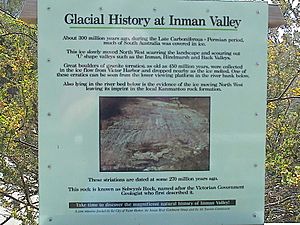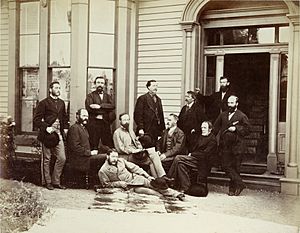Alfred Richard Cecil Selwyn facts for kids
Alfred Richard Cecil Selwyn (born July 26, 1824 – died October 19, 1902) was an important British geologist. He was a public servant who led geological surveys in two different countries. He was the director of the Geological Survey of Victoria in Australia from 1852 to 1869. Later, he became the director of the Geological Survey of Canada (GSC) from 1869 to 1894. He also served as President of the Royal Society of Canada.
Contents
Early Life and Geology Training
Alfred Selwyn was born in Kilmington, England. His father was a church leader, and his mother was from an important family. Alfred was taught at home by private tutors. He also studied in Switzerland, where he became very interested in geology. Geology is the study of Earth's rocks, minerals, and landforms.
In 1845, Selwyn joined the Geological Survey of Great Britain. This group mapped the geology of the country. He worked with famous geologists like Sir Henry De la Beche. Selwyn helped map North Wales and nearby areas. His work helped create excellent geological maps. He was promoted to geologist in 1848.
Geological Work in Australia
In 1852, Alfred Selwyn moved to Australia. He was chosen to lead the Geological Survey of Victoria. Victoria was a new colony at the time. Selwyn built a strong team of geologists. He expected high-quality work from everyone.
During his 17 years in Australia, his team created over 60 geological maps. These maps were very accurate for their time. They set a high standard for geological mapping in Australia. Selwyn also wrote many reports about Victoria's geology. He learned a lot about rocks that contain gold. In 1854, he found the Caledonian goldfield near Melbourne. He also reported on coal in Tasmania. The Survey ended in 1869 due to money problems.

Leading the Geological Survey of Canada
In 1869, Selwyn became the director of the Geological Survey of Canada (GSC). He was chosen by the previous director, Sir William E. Logan. This was a huge challenge for Selwyn. Canada had grown much larger after 1867. New territories like British Columbia joined the country. This meant the GSC had a much bigger area to map.
Selwyn led the GSC for 25 years. During this time, GSC geologists went on many expeditions. They explored new territories in the west and north. Selwyn often led these trips from the field. He was a skilled mountain climber, which helped him explore British Columbia's rugged mountains. British Columbia joined Canada in 1871. A railway was planned to connect it to eastern Canada. In 1871, Selwyn led a difficult trip to study the geology and minerals along the proposed railway routes.
The GSC needed more staff for all this exploration. Selwyn got more funding from the government. The number of field teams grew from six in 1870 to fourteen in 1890. In 1890, the Geological Survey became a separate government department. This showed how important the GSC was for Canada's growth.
Selwyn also had to move the GSC headquarters. It moved from Montreal to Ottawa in 1881. This was a big job. The GSC had a popular museum, and moving it caused some upset in Montreal. The move involved many heavy rock and fossil samples. Selwyn reported that they moved over 282,000 pounds of material!
Awards and Legacy
Alfred Selwyn received many honors for his work.
- In 1874, he became a member of the Royal Society.
- In 1876, he received the Murchison Medal from the Geological Society of London.
- He was made a CMG in 1886. This was for his work at exhibitions in Philadelphia, Paris, and London.
- In 1884, he received the Clarke Medal from the Royal Society of New South Wales.
- He also wrote the Canadian part of a geography book called Compendium of Geography and Travel.
Selwyn retired in 1894 and moved to Vancouver, British Columbia. He passed away on October 19, 1902.
Several places are named after him:
- Selwyn Rock in South Australia is a glacial pavement.
- The Selwyn Range in the Canadian Rockies.
- The Selwyn Range in North West Queensland, Australia.
- Selwyn Street in Hackett, Australia.
See Also
- Geological Survey of Canada
- Geological Survey of Victoria
Images for kids
-
In 1859 Selwyn discovered a glacial pavement at Inman Valley, later dated to the Permian






